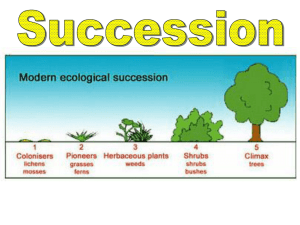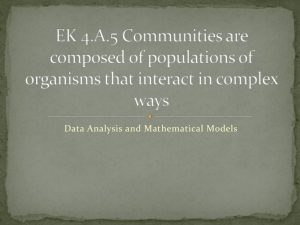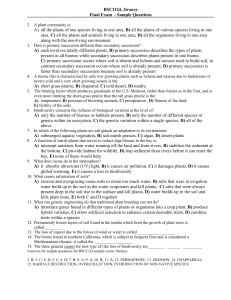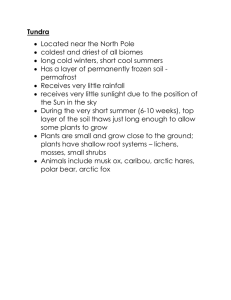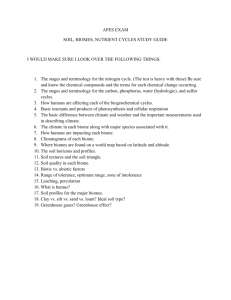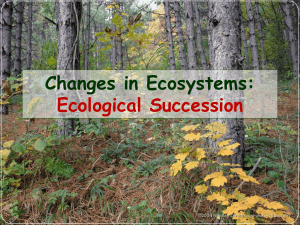EK 4.A.6 Interactions among living systems & with their environment
advertisement
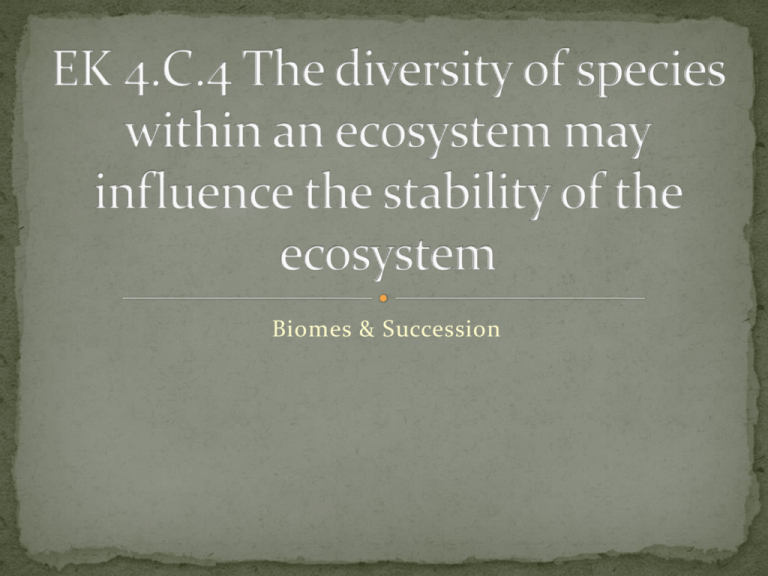
Biomes & Succession The biosphere is divided into regions called BIOMES that exhibit common environmental characteristics. Each biome is occupied by unique communities or ecosystems of plants and animals that share adaptations which promote survival within a biome. Tropical Rainforest High temperatures and heavy rainfall Tall trees with wide canopy that allows little light to reach forest floor Epiphytes – vines that grow on trees to reach the sun Savannas Grasslands with scattered trees Tropical regions – high temperature but receive much less water than a rainforest Hi Temp & Lo Water Temperate Grasslands Receive less water than savannas Lower temperatures than savannas Temperate Deciduous Forrest Warm summers, cold winters, and moderate precipitation Deciduous trees shed their leaves during the winter Deserts Hot & dry Growth of annual plants is limited to short periods following rains Plants and animals adapt to hot dry conditions Taigas Coniferous forests Winters are cold Precipitation is in the form of snow Tundra Ground freezing winters Thawing of upper soil layers in summer results in soggy soil Permafrost – deep soil is permanently frozen Fresh Water Biomes Ponds, lakes, streams and rivers Marine Biomes Estuaries, intertidal zones, continental shelves, coral reefs, and pelagic ocean The change in composition of species over time. Describes how one community with certain species is gradually and predictable replaced by another community consisting of different species. As succession progresses, species diversity and total biomass increase. Climax Community – final successional stage of constant species composition is attained which remains unchanged until destroyed by some catastrophic event. Physical and biological conditions influence the pace of succession – in both cases, the conditions which make a habitat attractive to resident species may no longer exist, making the habitat more favorable to a new species. Changes include: Substrate texture – change from solid rock, to sand, to fertile soil Soil pH – decrease due to the decomposition of organic matter Soil water potential – ability to retain water varies based on substrate Light availability – full sunlight to partly shady to total shade Crowding – increases with population growth Primary Succession Occurs on substrates that never previously supported living things. Occurs on volcanic islands, on lava flows, on rock left behind by retreating glaciers The first organisms to colonize a newly exposed habitat are called pioneer species Rock & Lava 1st pioneer species is typically lichens; hyphae of fungal component holds onto rock and absorbs moisture; lichen secretes acid which breaks down rock into soil; as soil accumulates more and more species can move in R-selected species will be replaced by K-selected species Sand Dunes – begins with the appearance of grasses adapted to taking root in shifting sands; grasses stabilize sand to allow for new species to follow Dunes of Lake Michigan are an example Process begins in habitats where communities were entirely of partially destroyed by some kind of damaging event – this event does not destroy the soil which allows secondary succession to proceed at a faster rate. Succession on abandoned cropland – begins with the germination of r-selected species from seeds already in the soil; trees follow Secondary succession of lakes and ponds – begins with a body of water, progresses to a marshlike state, then a meadow and finally to a climax community of native vegetation.
